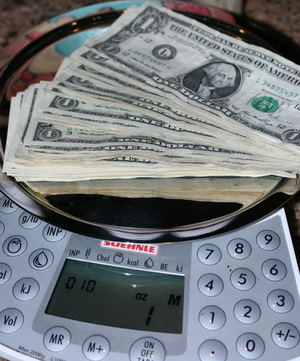At last count, Associated Content housed some 2,500 content pieces that addressed “a ton of money” in one form or another. Most deal with saving money (e.g., How To Plan A Fun Honeymoon…). But none that I could find addresses just how much a ton of money is worth.
TV and radio commercials also play up the savings of a ton of money.
Since my wife and I operate a math-tutoring center, we have found that real-life related problems like this are a great way to involve kids (and others) in the math process. And that’s our goal in life these days, since No Child Left Behind doesn’t seem to be doing its job (regardless of the published statistics).
So, let’s see how you do with the following math problem.
Compute the value of a ton of money. First, assume that each ton is composed of just one-dollar bills. Then repeat for quarters, dimes, nickels and pennies.
To work on this problem, I invaded my piggy bank and my wallet. I obtained the following information. Note that the observed weight I obtained for each unit of money is not a constant. From an educational perspective, this is a good thing. It fosters problem solving. From a realistic perspective, I had to go with the coinage I had available.
31 dollars = 1 oz
20 quarters = 4 oz
32 dimes = 3 oz
17 nickels = 3 oz
43 pennies = 4 oz
Please feel to have your children, neighbors and relatives try the problem, too.
STOP here while you solve the problem!
After you solve (or attempt to solve) the problem, please read on to see one way to determine the value of a ton of money.
First we need to weigh our money. As noted above, I’ve done this for you. But if you want to weigh your own money, feel free to do so. Just recognize that due to small variations in coinage weights and variations in scale accuracy, your numbers may not match mine exactly. You can also find actual weight (mass) values from the Federal Reserve Banks web site (answers 7 and 21).
Next you need to know how much a ton weighs. But there is more than one type of ton. Go figure!
A U. S. short ton is 2000 pounds and a British long ton is 2,240 pounds. For purposes of this discussion, we’ll stick with the U.S. short ton (a.k.a. “ton”). My friends in the U.K. can solve the problem using their tonnage system.
Perhaps the easiest way to solve this problem is to find out how many of each unit of money equals one pound. For any of the units, first multiply both sides of each equation by 16. For dollars (one dollar bills, specifically), this immediately takes you to $496 equals one pound.
For the other units, you now need to transform the equation into the same number of pounds as the original number of ounces. You also need to find the number of coins that equals that weight. Nickels, for example, you multiply by 16, which yields 272 nickels, equaling 3 pounds.
The next step is to change the number of a particular coin into its monetary value. For nickels, 272 nickels becomes $13.60 equals 3 pounds. Now, dividing by 3 tells us that $4.533… worth of nickels equals one pound.
Finally multiply by 2000 to obtain the value of a ton of money.
If your answers for a ton of each money unit are approximately
$992,000 in dollars
$ 40,000 in quarters
$ 9,066 in nickels
$ 34,140 in dimes
$ 3,140 in pennies
you’ve done a good job handling the math.
Regardless, you can see that a ton of money can be different things depending upon the monetary unit chosen. Of course, if we had weighed one hundred dollar bills…

